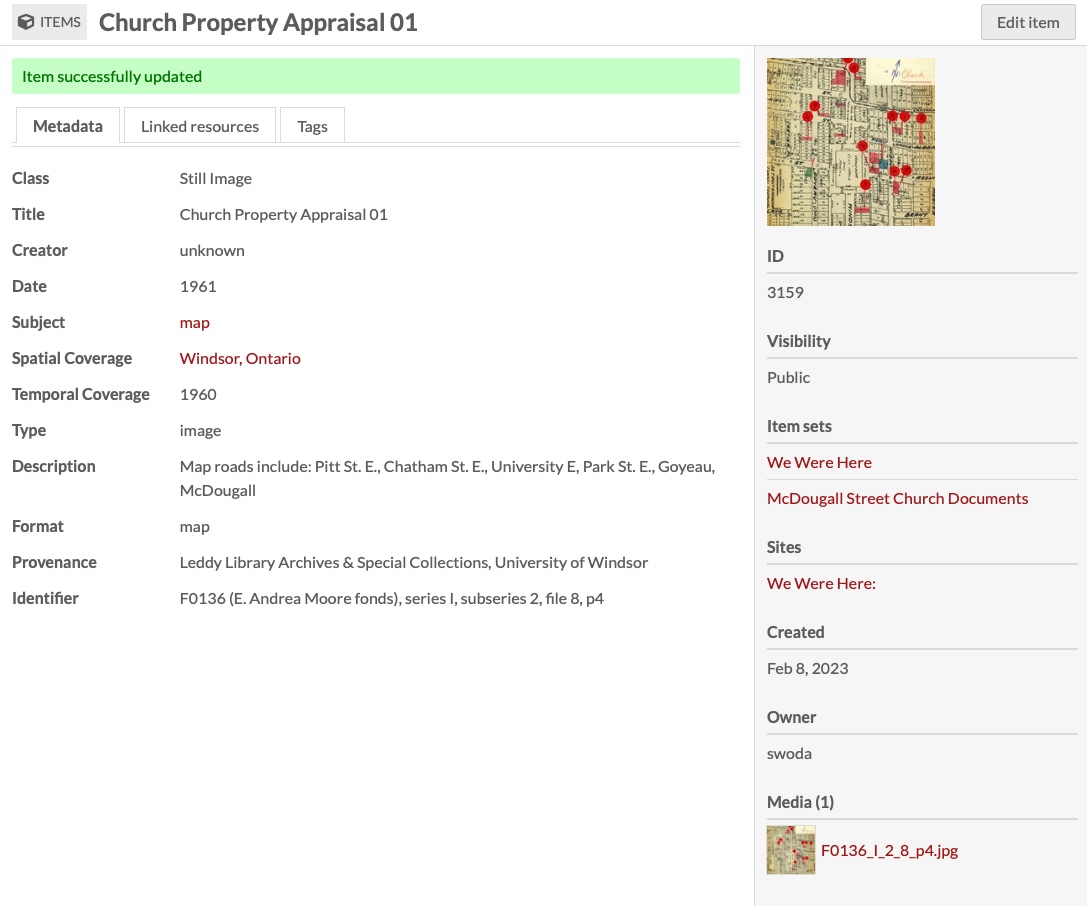We Were Here and Librarianship, Dr Heidi LM Jacobs
Librarianship and the Building of the We Were Here: Recovering the Stories of Windsor's McDougall Street Corridor portal
Dr Heidi LM Jacobs
We Were Here: Recovering the Stories of Windsor's McDougall Street Corridor involves several components: an oral history project to preserve the stories and memories of the McDougall Street residents; a collection and selective digitization of relevant photographs, clippings, and documents; a digital map with images and information; and a collection of essays describing the long and fascinating history of the McDougall Street Corridor. Collectively these components help to preserve and share the story of a place that generations of people called—and still call —home. Please visit the “Other Resources” page to see related and adjacent initiatives that document and explore the McDougall Street Corridor.

The web portal you are now visiting is represents a collaborative effort between the Essex County Black Historical Research Society (ECBHRS) and the University of Windsor’s Leddy Library. Our intention is not only to document the history of the McDougall Street Corridor but also to preserve and share the stories of those who were there. The ECBHRS-Leddy partnership was made possible through funding from a University of Windsor Anti-Black Racism Student Leadership Engagement Grant (2021-2023). The original project team brought together Irene Moore Davis, a community historian, Willow Key, a History graduate student, Sarah Glassford, an archivist, and me, a librarian. After pooling our collective resources and skills we created We Were Here: Recovering the Stories of Windsor's McDougall Street Corridor.
Sharing the We Were Here Story
Although the story of the Corridor is less than sixty years old, many of those who lived there and remembered it are no longer with us. Further, much of the extant documentation about this neighbourhood is scattered across the community, much of it not publicly accessible. With each passing year, memories and documents, particularly from under-represented groups in Canada such as the McDougall Street residents, grow ever more fragile and precarious. One of the goals of We Were Here is to make this rich and vital history more visible and accessible and to tell the story from the community’s perspectives.
We Were Here: Recovering the Stories of Windsor's McDougall Street Corridor is a testament to the depth of the historical record that, at time of writing, existed nowhere else but in people’s memories, in family scrapbooks and photo albums, in newspaper clippings, and in brittle, archived documents long filed away and forgotten. As Irene Moore Davis and Willow Key gathered and assembled these fragments of the past, we at Leddy Library considered how best to organize and preserve them, to facilitate their use by current and future researchers.
Librarianship and We Were Here
The theoretical thinking of librarians and archivists deeply informs digital public history projects like this one. Often this work is indelible and yet also invisible. The praxis of librarianship has deeply informed We Were Here.
In their Core Values of Librarianship document (2019), the American Library Association lists twelve values that “define, inform, and guide our professional practice.” Among these twelve, the values of access, diversity, education and lifelong learning, the public good, preservation, and social responsibility resonate deeply with the project members. Accordingly, these core values shaped our research directions and the shape of this web portal. We considered, at length, how best to support access to the materials related to this story, preserve documents and memories, promote a more diverse and informed view of our city’s history, and encourage life-long learning and further inquiry and scholarship in this area.
To achieve these ends, Leddy Library decided on a hybrid approach, making much of the story available digitally, through contextual essays and a curated selection of digitized images and documents, but also committing to building a physical collection in our Archives and Special Collections that will continue to inform and shape the story of this neighbourhood in decades to come.
Digitization and the development of digital archives and digital exhibits is, of course, a vital and immediate way to bring history—in particular lesser-known histories— into our classrooms, , our imaginations, and our critical consciousnesses. But digital exhibits—no matter how extensive—can only tell part of the story. Indeed, this is a story without an ending— it is a story that continues to evolve.
We Were Here as an Invitation
Our intention was to present the digital component of We Were Here as an invitation for further research and exploration. For this reason, we call it a digital portal. It is not an ending spot but a door that we invite you—community members, students, or scholars— to open. We hope you will read the essays and look at the images so that you can learn more about the Black experience not only in Windsor but in cities elsewhere in North America were similar community dislocations occurred. We want to tempt you with examples of images and documents that can be found in our Archives and Special Collections and other local institutions, and invite you to visit them and investigate further. We encourage you to use the map and explore this Windsor neighbourhood on foot or online, and to remember or imagine what was here before the 1960s.
Above all, we invite you to read these stories about the McDougall Street Corridor and think about what other histories are missing from the larger narratives. Then ask yourself what you can do to preserve and share those histories – vital community stories that also need to be heard.
